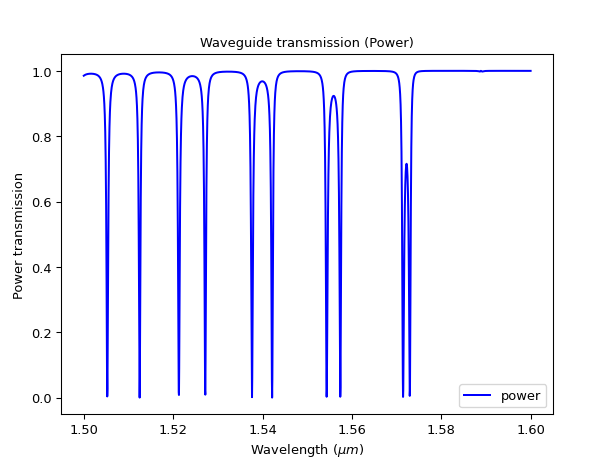ConnectComponents¶
- class picazzo3.routing.place_route.cell.ConnectComponents(*args, **kwargs)¶
Parametric Cell for logically connecting multiple components.
The user supplies a dictionary of the instances of child cells that need to be placed through the property
child_cells. This dictionary maps the instance names to the PCell objects. The same PCell object can be used for multiple instances.child_cells={ "ring1" : my_ring1, "ring2" : my_ring2, "spl" : my_splitter, "com" : my_splitter # the same cell is used both for splitting and combining }
The connectivity between the instances of the child cells is set by a list of tuples containing pairs of instance terms/port names. This list
linksis of the forminstname:portnamelinks=[ ("spl:arm1", "arm1:in1"), ("arm1:out1", "com:arm1"), ("spl:arm2", "arm2:in1"), ("arm2:out1", "com:arm2") ]
All the terms of the instances are connected to outside terms. You can override the default external term names using the
external_port_namesproperty. There you can specify the individual names of the external terms. If no name is specified, the default pattern of ‘instname_termname’ will be used.external_port_names={ "spl:in1" : "input", "com:out1" : "output" }
- Parameters
- links: list and List with type restriction, allowed types: [<class ‘collections.abc.Sequence’>]
list of tuples connecting the instances. Format is [(‘inst1:term1’,’inst2:term2’), …]
- child_cells:
dict to create the instances of the child cells.Format is {‘inst_name1’: PCell}
- external_port_names: str
Map of the free instance terms/ports to the names of external terms/ports.Format is a dict {‘inst:term’ : ‘new_term_name’}.If a term/port is not listed, the format instname_portname will be used
- name: String that contains only ISO/IEC 8859-1 (extended ASCII py3) or pure ASCII (py2) characters
The unique name of the pcell
Examples
"""Here we connect 2 splitters and two rings into a RLMZI We use the splitter twice but use two different rings. """ from technologies import silicon_photonics # noqa: F401 from ipkiss3 import all as i3 # noqa: F401 import numpy as np import pylab as plt from picazzo3.filters.ring import RingRectNotchFilter from picazzo3.wg.splitters import WgY90Splitter from picazzo3.routing.place_route import ConnectComponents ring1 = RingRectNotchFilter() cp = {"cross_coupling1": 0.4j, "straight_coupling1": (1 - 0.4**2) ** 0.5} ring1.CircuitModel(coupler_parameters=[cp], ring_length=50.0) ring2 = RingRectNotchFilter() ring2.CircuitModel(coupler_parameters=[cp], ring_length=55.0) splitter = WgY90Splitter() pc = ConnectComponents( child_cells={"spl": splitter, "com": splitter, "arm1": ring1, "arm2": ring2}, links=[ ("spl:arm1", "arm1:in"), ("arm1:out", "com:arm1"), ("spl:arm2", "arm2:in"), ("arm2:out", "com:arm2"), ], ) cm = pc.CircuitModel() # Caphe simulation wavelengths = np.linspace(1.50, 1.6, 2001) R = cm.get_smatrix(wavelengths=wavelengths) plt.plot(wavelengths, np.abs(R["spl_center", "com_center"]) ** 2, "b", label="power") plt.title("Waveguide transmission (Power)") plt.xlabel(r"Wavelength ($\mu m$)") plt.ylabel("Power transmission") plt.legend() plt.show()

Views
- Layout = <class 'ipkiss3.pcell.container.connect_components.ConnectComponents.Layout'>¶